Leadership and Management Operations Report: M&S Retail Analysis
VerifiedAdded on 2021/01/01
|15
|4147
|245
Report
AI Summary
This report examines the management and operations of Marks & Spencer (M&S), a multinational British retailer. It begins by differentiating between leaders and managers, outlining their distinct roles, characteristics, and impact on organizational goals. The report then delves into the specific roles of leaders in motivating and guiding employees, alongside the functions of managers, including planning, organizing, commanding, coordinating, and controlling. It explores how leaders and managers address various situations, such as conflict management and employee engagement, and discusses different leadership theories like situational, systems, and contingency leadership. The report further analyzes the strengths and weaknesses of these theories and concludes by assessing the impact of leaders and managers on M&S's decision-making and operational strategies, including key approaches like Just in Time inventory management. The report emphasizes the importance of effective leadership and management in achieving sustainable development within the retail industry.
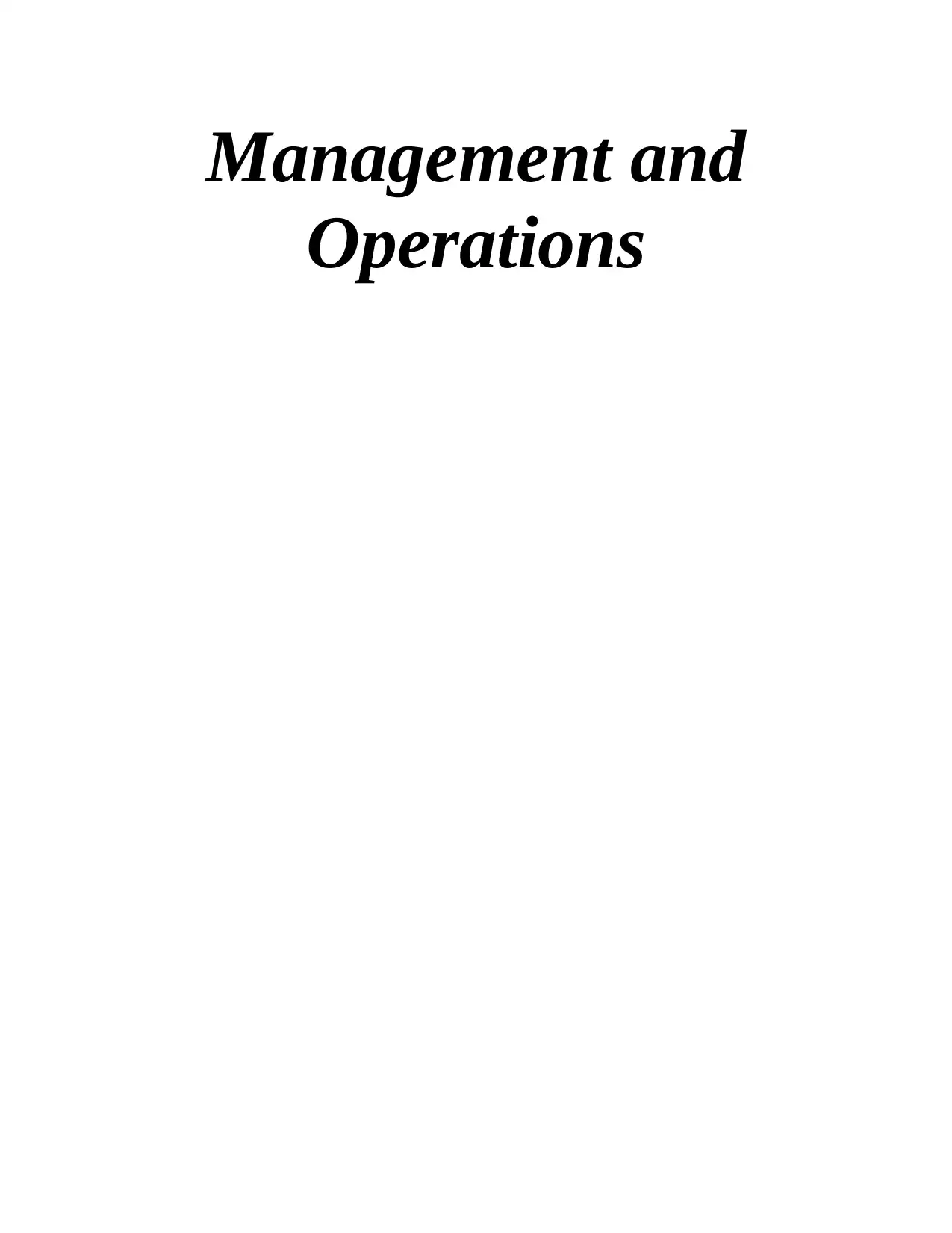
Management and
Operations
Operations
Paraphrase This Document
Need a fresh take? Get an instant paraphrase of this document with our AI Paraphraser
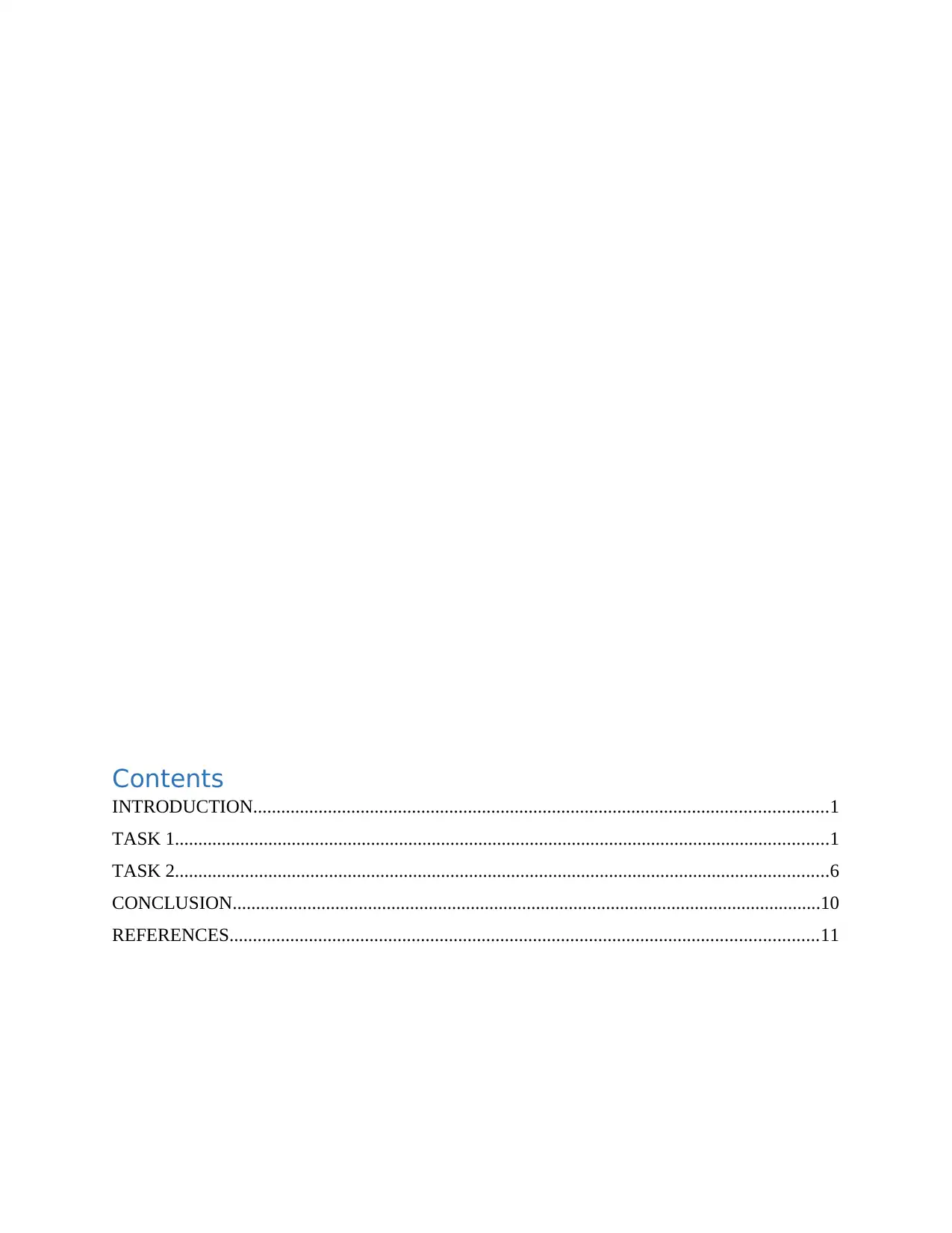
Contents
INTRODUCTION...........................................................................................................................1
TASK 1............................................................................................................................................1
TASK 2............................................................................................................................................6
CONCLUSION..............................................................................................................................10
REFERENCES..............................................................................................................................11
INTRODUCTION...........................................................................................................................1
TASK 1............................................................................................................................................1
TASK 2............................................................................................................................................6
CONCLUSION..............................................................................................................................10
REFERENCES..............................................................................................................................11

⊘ This is a preview!⊘
Do you want full access?
Subscribe today to unlock all pages.

Trusted by 1+ million students worldwide
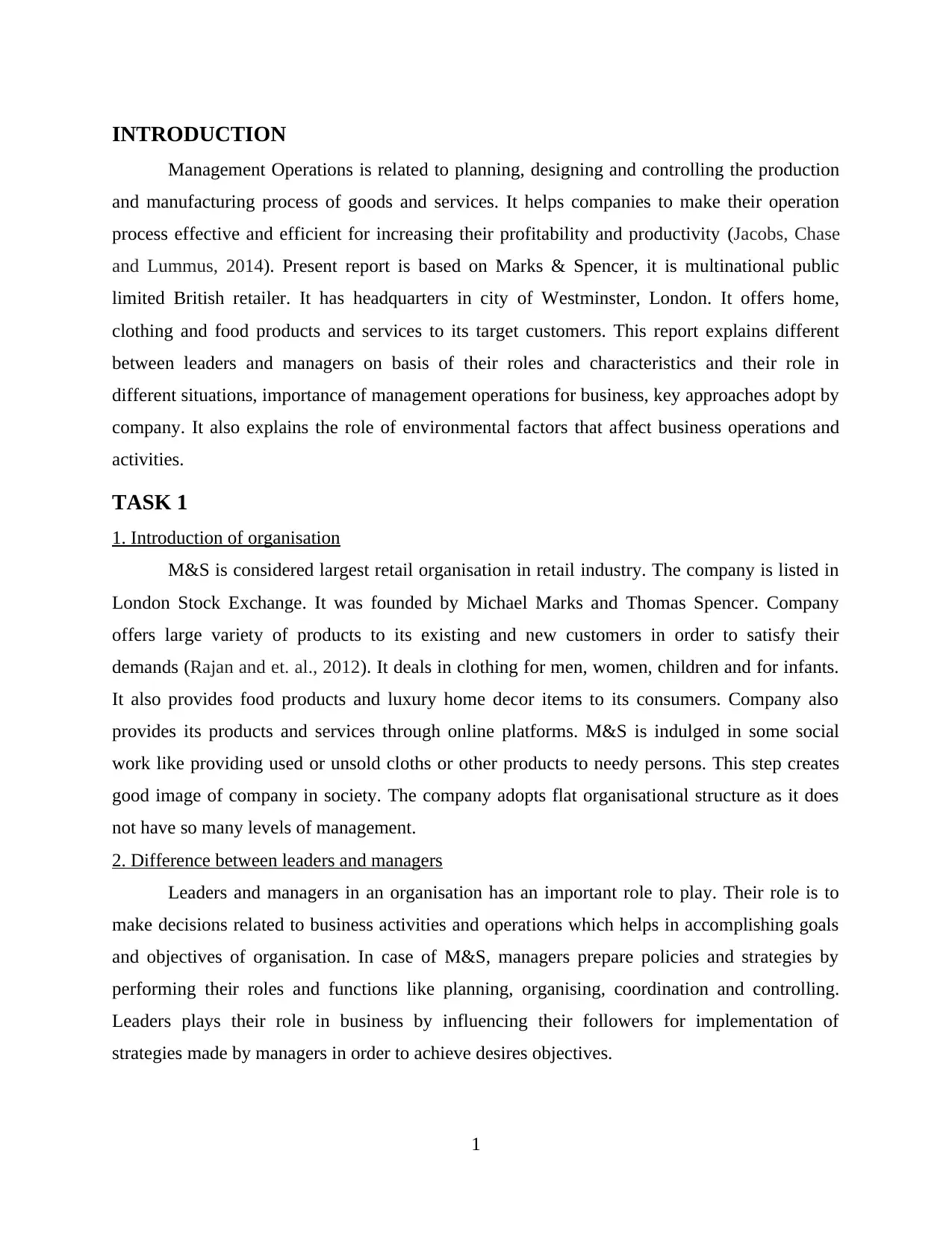
INTRODUCTION
Management Operations is related to planning, designing and controlling the production
and manufacturing process of goods and services. It helps companies to make their operation
process effective and efficient for increasing their profitability and productivity (Jacobs, Chase
and Lummus, 2014). Present report is based on Marks & Spencer, it is multinational public
limited British retailer. It has headquarters in city of Westminster, London. It offers home,
clothing and food products and services to its target customers. This report explains different
between leaders and managers on basis of their roles and characteristics and their role in
different situations, importance of management operations for business, key approaches adopt by
company. It also explains the role of environmental factors that affect business operations and
activities.
TASK 1
1. Introduction of organisation
M&S is considered largest retail organisation in retail industry. The company is listed in
London Stock Exchange. It was founded by Michael Marks and Thomas Spencer. Company
offers large variety of products to its existing and new customers in order to satisfy their
demands (Rajan and et. al., 2012). It deals in clothing for men, women, children and for infants.
It also provides food products and luxury home decor items to its consumers. Company also
provides its products and services through online platforms. M&S is indulged in some social
work like providing used or unsold cloths or other products to needy persons. This step creates
good image of company in society. The company adopts flat organisational structure as it does
not have so many levels of management.
2. Difference between leaders and managers
Leaders and managers in an organisation has an important role to play. Their role is to
make decisions related to business activities and operations which helps in accomplishing goals
and objectives of organisation. In case of M&S, managers prepare policies and strategies by
performing their roles and functions like planning, organising, coordination and controlling.
Leaders plays their role in business by influencing their followers for implementation of
strategies made by managers in order to achieve desires objectives.
1
Management Operations is related to planning, designing and controlling the production
and manufacturing process of goods and services. It helps companies to make their operation
process effective and efficient for increasing their profitability and productivity (Jacobs, Chase
and Lummus, 2014). Present report is based on Marks & Spencer, it is multinational public
limited British retailer. It has headquarters in city of Westminster, London. It offers home,
clothing and food products and services to its target customers. This report explains different
between leaders and managers on basis of their roles and characteristics and their role in
different situations, importance of management operations for business, key approaches adopt by
company. It also explains the role of environmental factors that affect business operations and
activities.
TASK 1
1. Introduction of organisation
M&S is considered largest retail organisation in retail industry. The company is listed in
London Stock Exchange. It was founded by Michael Marks and Thomas Spencer. Company
offers large variety of products to its existing and new customers in order to satisfy their
demands (Rajan and et. al., 2012). It deals in clothing for men, women, children and for infants.
It also provides food products and luxury home decor items to its consumers. Company also
provides its products and services through online platforms. M&S is indulged in some social
work like providing used or unsold cloths or other products to needy persons. This step creates
good image of company in society. The company adopts flat organisational structure as it does
not have so many levels of management.
2. Difference between leaders and managers
Leaders and managers in an organisation has an important role to play. Their role is to
make decisions related to business activities and operations which helps in accomplishing goals
and objectives of organisation. In case of M&S, managers prepare policies and strategies by
performing their roles and functions like planning, organising, coordination and controlling.
Leaders plays their role in business by influencing their followers for implementation of
strategies made by managers in order to achieve desires objectives.
1
Paraphrase This Document
Need a fresh take? Get an instant paraphrase of this document with our AI Paraphraser
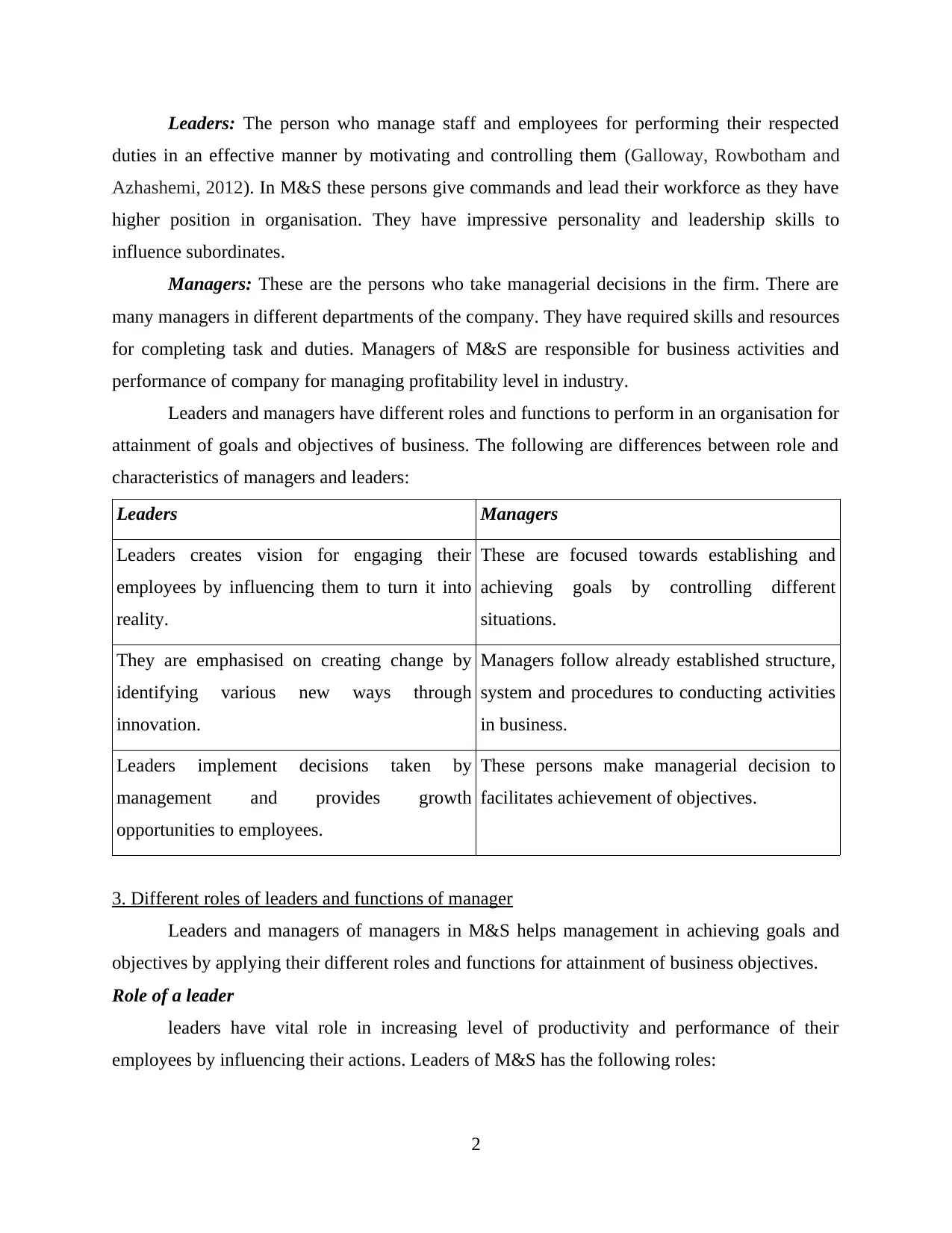
Leaders: The person who manage staff and employees for performing their respected
duties in an effective manner by motivating and controlling them (Galloway, Rowbotham and
Azhashemi, 2012). In M&S these persons give commands and lead their workforce as they have
higher position in organisation. They have impressive personality and leadership skills to
influence subordinates.
Managers: These are the persons who take managerial decisions in the firm. There are
many managers in different departments of the company. They have required skills and resources
for completing task and duties. Managers of M&S are responsible for business activities and
performance of company for managing profitability level in industry.
Leaders and managers have different roles and functions to perform in an organisation for
attainment of goals and objectives of business. The following are differences between role and
characteristics of managers and leaders:
Leaders Managers
Leaders creates vision for engaging their
employees by influencing them to turn it into
reality.
These are focused towards establishing and
achieving goals by controlling different
situations.
They are emphasised on creating change by
identifying various new ways through
innovation.
Managers follow already established structure,
system and procedures to conducting activities
in business.
Leaders implement decisions taken by
management and provides growth
opportunities to employees.
These persons make managerial decision to
facilitates achievement of objectives.
3. Different roles of leaders and functions of manager
Leaders and managers of managers in M&S helps management in achieving goals and
objectives by applying their different roles and functions for attainment of business objectives.
Role of a leader
leaders have vital role in increasing level of productivity and performance of their
employees by influencing their actions. Leaders of M&S has the following roles:
2
duties in an effective manner by motivating and controlling them (Galloway, Rowbotham and
Azhashemi, 2012). In M&S these persons give commands and lead their workforce as they have
higher position in organisation. They have impressive personality and leadership skills to
influence subordinates.
Managers: These are the persons who take managerial decisions in the firm. There are
many managers in different departments of the company. They have required skills and resources
for completing task and duties. Managers of M&S are responsible for business activities and
performance of company for managing profitability level in industry.
Leaders and managers have different roles and functions to perform in an organisation for
attainment of goals and objectives of business. The following are differences between role and
characteristics of managers and leaders:
Leaders Managers
Leaders creates vision for engaging their
employees by influencing them to turn it into
reality.
These are focused towards establishing and
achieving goals by controlling different
situations.
They are emphasised on creating change by
identifying various new ways through
innovation.
Managers follow already established structure,
system and procedures to conducting activities
in business.
Leaders implement decisions taken by
management and provides growth
opportunities to employees.
These persons make managerial decision to
facilitates achievement of objectives.
3. Different roles of leaders and functions of manager
Leaders and managers of managers in M&S helps management in achieving goals and
objectives by applying their different roles and functions for attainment of business objectives.
Role of a leader
leaders have vital role in increasing level of productivity and performance of their
employees by influencing their actions. Leaders of M&S has the following roles:
2
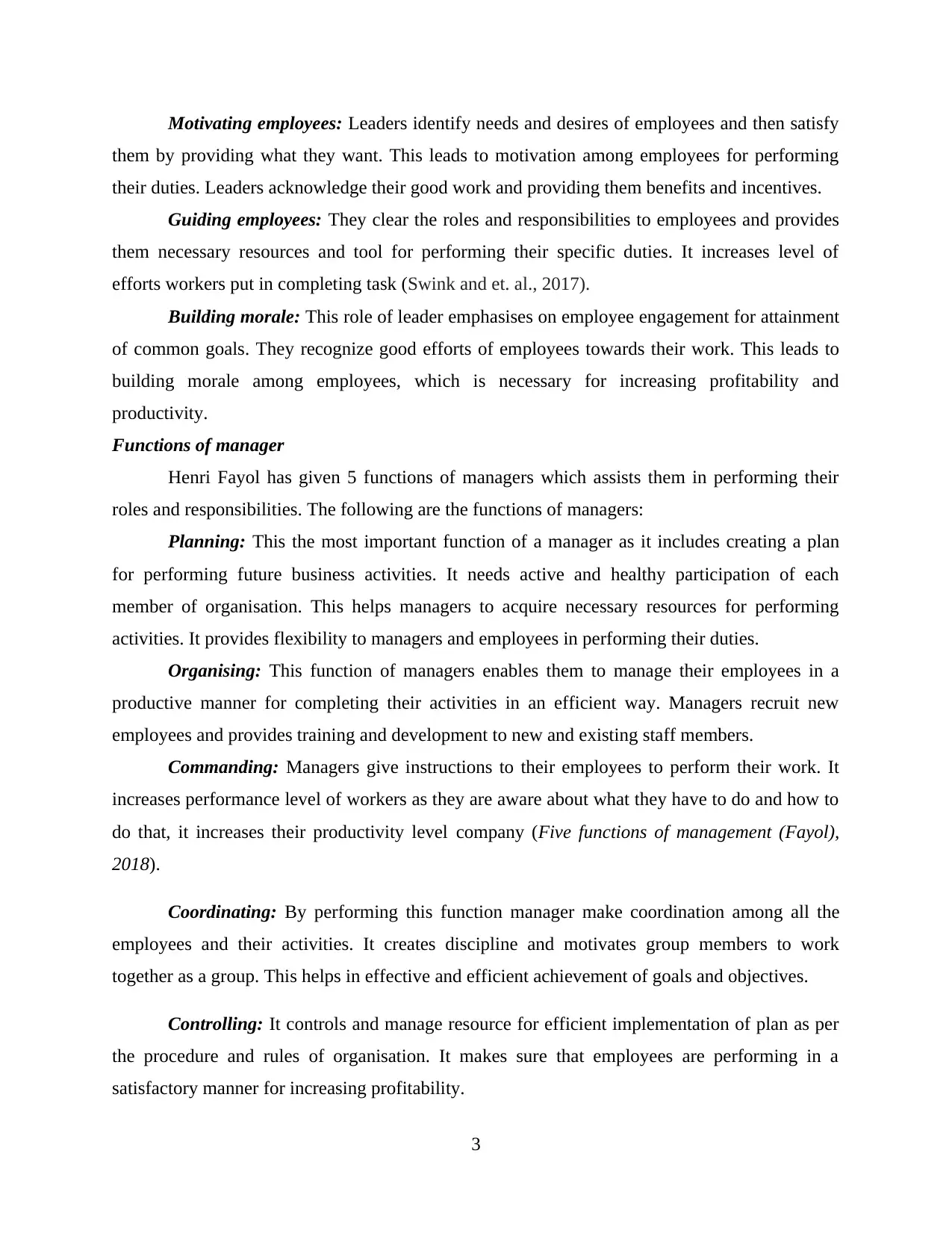
Motivating employees: Leaders identify needs and desires of employees and then satisfy
them by providing what they want. This leads to motivation among employees for performing
their duties. Leaders acknowledge their good work and providing them benefits and incentives.
Guiding employees: They clear the roles and responsibilities to employees and provides
them necessary resources and tool for performing their specific duties. It increases level of
efforts workers put in completing task (Swink and et. al., 2017).
Building morale: This role of leader emphasises on employee engagement for attainment
of common goals. They recognize good efforts of employees towards their work. This leads to
building morale among employees, which is necessary for increasing profitability and
productivity.
Functions of manager
Henri Fayol has given 5 functions of managers which assists them in performing their
roles and responsibilities. The following are the functions of managers:
Planning: This the most important function of a manager as it includes creating a plan
for performing future business activities. It needs active and healthy participation of each
member of organisation. This helps managers to acquire necessary resources for performing
activities. It provides flexibility to managers and employees in performing their duties.
Organising: This function of managers enables them to manage their employees in a
productive manner for completing their activities in an efficient way. Managers recruit new
employees and provides training and development to new and existing staff members.
Commanding: Managers give instructions to their employees to perform their work. It
increases performance level of workers as they are aware about what they have to do and how to
do that, it increases their productivity level company (Five functions of management (Fayol),
2018).
Coordinating: By performing this function manager make coordination among all the
employees and their activities. It creates discipline and motivates group members to work
together as a group. This helps in effective and efficient achievement of goals and objectives.
Controlling: It controls and manage resource for efficient implementation of plan as per
the procedure and rules of organisation. It makes sure that employees are performing in a
satisfactory manner for increasing profitability.
3
them by providing what they want. This leads to motivation among employees for performing
their duties. Leaders acknowledge their good work and providing them benefits and incentives.
Guiding employees: They clear the roles and responsibilities to employees and provides
them necessary resources and tool for performing their specific duties. It increases level of
efforts workers put in completing task (Swink and et. al., 2017).
Building morale: This role of leader emphasises on employee engagement for attainment
of common goals. They recognize good efforts of employees towards their work. This leads to
building morale among employees, which is necessary for increasing profitability and
productivity.
Functions of manager
Henri Fayol has given 5 functions of managers which assists them in performing their
roles and responsibilities. The following are the functions of managers:
Planning: This the most important function of a manager as it includes creating a plan
for performing future business activities. It needs active and healthy participation of each
member of organisation. This helps managers to acquire necessary resources for performing
activities. It provides flexibility to managers and employees in performing their duties.
Organising: This function of managers enables them to manage their employees in a
productive manner for completing their activities in an efficient way. Managers recruit new
employees and provides training and development to new and existing staff members.
Commanding: Managers give instructions to their employees to perform their work. It
increases performance level of workers as they are aware about what they have to do and how to
do that, it increases their productivity level company (Five functions of management (Fayol),
2018).
Coordinating: By performing this function manager make coordination among all the
employees and their activities. It creates discipline and motivates group members to work
together as a group. This helps in effective and efficient achievement of goals and objectives.
Controlling: It controls and manage resource for efficient implementation of plan as per
the procedure and rules of organisation. It makes sure that employees are performing in a
satisfactory manner for increasing profitability.
3
⊘ This is a preview!⊘
Do you want full access?
Subscribe today to unlock all pages.

Trusted by 1+ million students worldwide
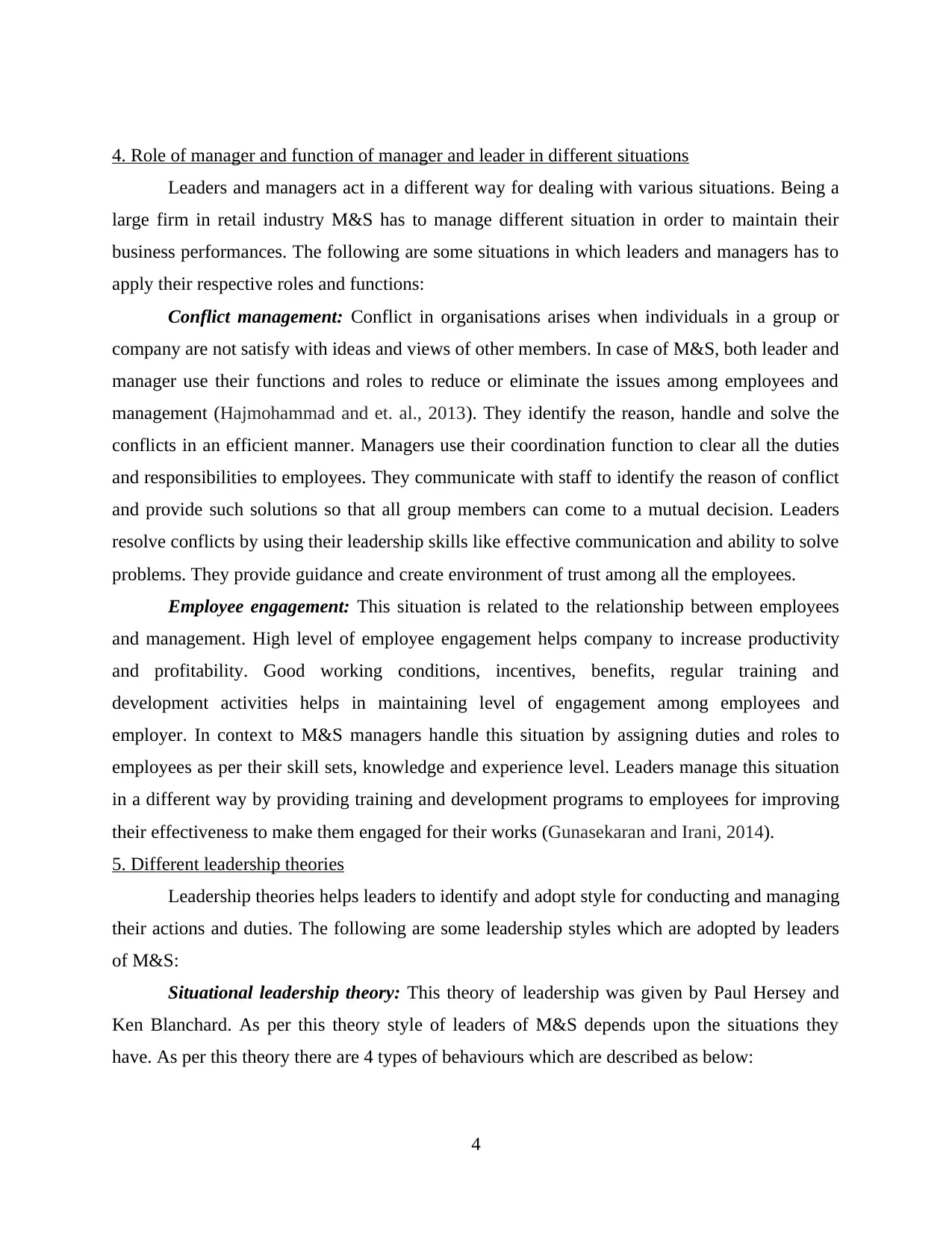
4. Role of manager and function of manager and leader in different situations
Leaders and managers act in a different way for dealing with various situations. Being a
large firm in retail industry M&S has to manage different situation in order to maintain their
business performances. The following are some situations in which leaders and managers has to
apply their respective roles and functions:
Conflict management: Conflict in organisations arises when individuals in a group or
company are not satisfy with ideas and views of other members. In case of M&S, both leader and
manager use their functions and roles to reduce or eliminate the issues among employees and
management (Hajmohammad and et. al., 2013). They identify the reason, handle and solve the
conflicts in an efficient manner. Managers use their coordination function to clear all the duties
and responsibilities to employees. They communicate with staff to identify the reason of conflict
and provide such solutions so that all group members can come to a mutual decision. Leaders
resolve conflicts by using their leadership skills like effective communication and ability to solve
problems. They provide guidance and create environment of trust among all the employees.
Employee engagement: This situation is related to the relationship between employees
and management. High level of employee engagement helps company to increase productivity
and profitability. Good working conditions, incentives, benefits, regular training and
development activities helps in maintaining level of engagement among employees and
employer. In context to M&S managers handle this situation by assigning duties and roles to
employees as per their skill sets, knowledge and experience level. Leaders manage this situation
in a different way by providing training and development programs to employees for improving
their effectiveness to make them engaged for their works (Gunasekaran and Irani, 2014).
5. Different leadership theories
Leadership theories helps leaders to identify and adopt style for conducting and managing
their actions and duties. The following are some leadership styles which are adopted by leaders
of M&S:
Situational leadership theory: This theory of leadership was given by Paul Hersey and
Ken Blanchard. As per this theory style of leaders of M&S depends upon the situations they
have. As per this theory there are 4 types of behaviours which are described as below:
4
Leaders and managers act in a different way for dealing with various situations. Being a
large firm in retail industry M&S has to manage different situation in order to maintain their
business performances. The following are some situations in which leaders and managers has to
apply their respective roles and functions:
Conflict management: Conflict in organisations arises when individuals in a group or
company are not satisfy with ideas and views of other members. In case of M&S, both leader and
manager use their functions and roles to reduce or eliminate the issues among employees and
management (Hajmohammad and et. al., 2013). They identify the reason, handle and solve the
conflicts in an efficient manner. Managers use their coordination function to clear all the duties
and responsibilities to employees. They communicate with staff to identify the reason of conflict
and provide such solutions so that all group members can come to a mutual decision. Leaders
resolve conflicts by using their leadership skills like effective communication and ability to solve
problems. They provide guidance and create environment of trust among all the employees.
Employee engagement: This situation is related to the relationship between employees
and management. High level of employee engagement helps company to increase productivity
and profitability. Good working conditions, incentives, benefits, regular training and
development activities helps in maintaining level of engagement among employees and
employer. In context to M&S managers handle this situation by assigning duties and roles to
employees as per their skill sets, knowledge and experience level. Leaders manage this situation
in a different way by providing training and development programs to employees for improving
their effectiveness to make them engaged for their works (Gunasekaran and Irani, 2014).
5. Different leadership theories
Leadership theories helps leaders to identify and adopt style for conducting and managing
their actions and duties. The following are some leadership styles which are adopted by leaders
of M&S:
Situational leadership theory: This theory of leadership was given by Paul Hersey and
Ken Blanchard. As per this theory style of leaders of M&S depends upon the situations they
have. As per this theory there are 4 types of behaviours which are described as below:
4
Paraphrase This Document
Need a fresh take? Get an instant paraphrase of this document with our AI Paraphraser
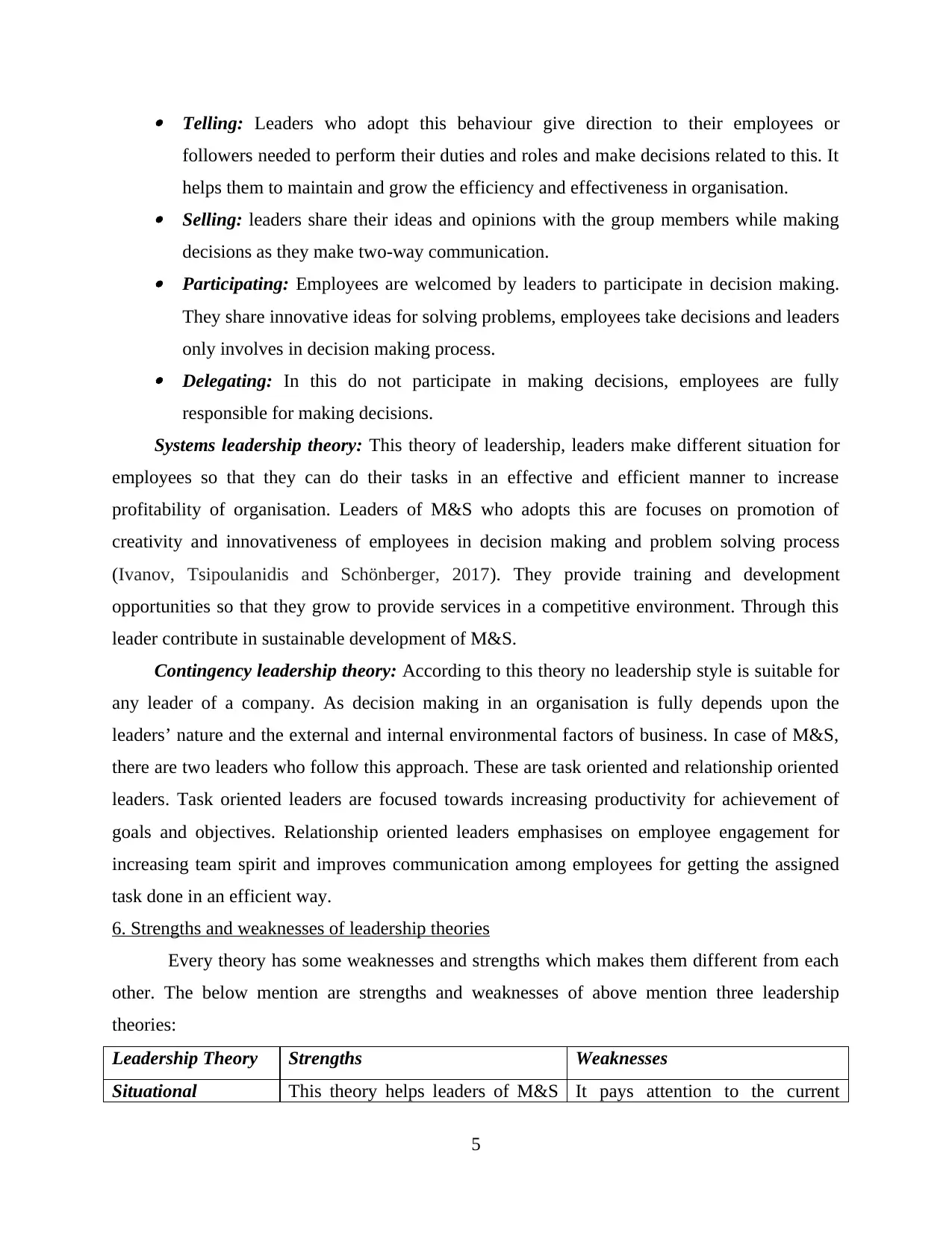
Telling: Leaders who adopt this behaviour give direction to their employees or
followers needed to perform their duties and roles and make decisions related to this. It
helps them to maintain and grow the efficiency and effectiveness in organisation. Selling: leaders share their ideas and opinions with the group members while making
decisions as they make two-way communication. Participating: Employees are welcomed by leaders to participate in decision making.
They share innovative ideas for solving problems, employees take decisions and leaders
only involves in decision making process. Delegating: In this do not participate in making decisions, employees are fully
responsible for making decisions.
Systems leadership theory: This theory of leadership, leaders make different situation for
employees so that they can do their tasks in an effective and efficient manner to increase
profitability of organisation. Leaders of M&S who adopts this are focuses on promotion of
creativity and innovativeness of employees in decision making and problem solving process
(Ivanov, Tsipoulanidis and Schönberger, 2017). They provide training and development
opportunities so that they grow to provide services in a competitive environment. Through this
leader contribute in sustainable development of M&S.
Contingency leadership theory: According to this theory no leadership style is suitable for
any leader of a company. As decision making in an organisation is fully depends upon the
leaders’ nature and the external and internal environmental factors of business. In case of M&S,
there are two leaders who follow this approach. These are task oriented and relationship oriented
leaders. Task oriented leaders are focused towards increasing productivity for achievement of
goals and objectives. Relationship oriented leaders emphasises on employee engagement for
increasing team spirit and improves communication among employees for getting the assigned
task done in an efficient way.
6. Strengths and weaknesses of leadership theories
Every theory has some weaknesses and strengths which makes them different from each
other. The below mention are strengths and weaknesses of above mention three leadership
theories:
Leadership Theory Strengths Weaknesses
Situational This theory helps leaders of M&S It pays attention to the current
5
followers needed to perform their duties and roles and make decisions related to this. It
helps them to maintain and grow the efficiency and effectiveness in organisation. Selling: leaders share their ideas and opinions with the group members while making
decisions as they make two-way communication. Participating: Employees are welcomed by leaders to participate in decision making.
They share innovative ideas for solving problems, employees take decisions and leaders
only involves in decision making process. Delegating: In this do not participate in making decisions, employees are fully
responsible for making decisions.
Systems leadership theory: This theory of leadership, leaders make different situation for
employees so that they can do their tasks in an effective and efficient manner to increase
profitability of organisation. Leaders of M&S who adopts this are focuses on promotion of
creativity and innovativeness of employees in decision making and problem solving process
(Ivanov, Tsipoulanidis and Schönberger, 2017). They provide training and development
opportunities so that they grow to provide services in a competitive environment. Through this
leader contribute in sustainable development of M&S.
Contingency leadership theory: According to this theory no leadership style is suitable for
any leader of a company. As decision making in an organisation is fully depends upon the
leaders’ nature and the external and internal environmental factors of business. In case of M&S,
there are two leaders who follow this approach. These are task oriented and relationship oriented
leaders. Task oriented leaders are focused towards increasing productivity for achievement of
goals and objectives. Relationship oriented leaders emphasises on employee engagement for
increasing team spirit and improves communication among employees for getting the assigned
task done in an efficient way.
6. Strengths and weaknesses of leadership theories
Every theory has some weaknesses and strengths which makes them different from each
other. The below mention are strengths and weaknesses of above mention three leadership
theories:
Leadership Theory Strengths Weaknesses
Situational This theory helps leaders of M&S It pays attention to the current
5
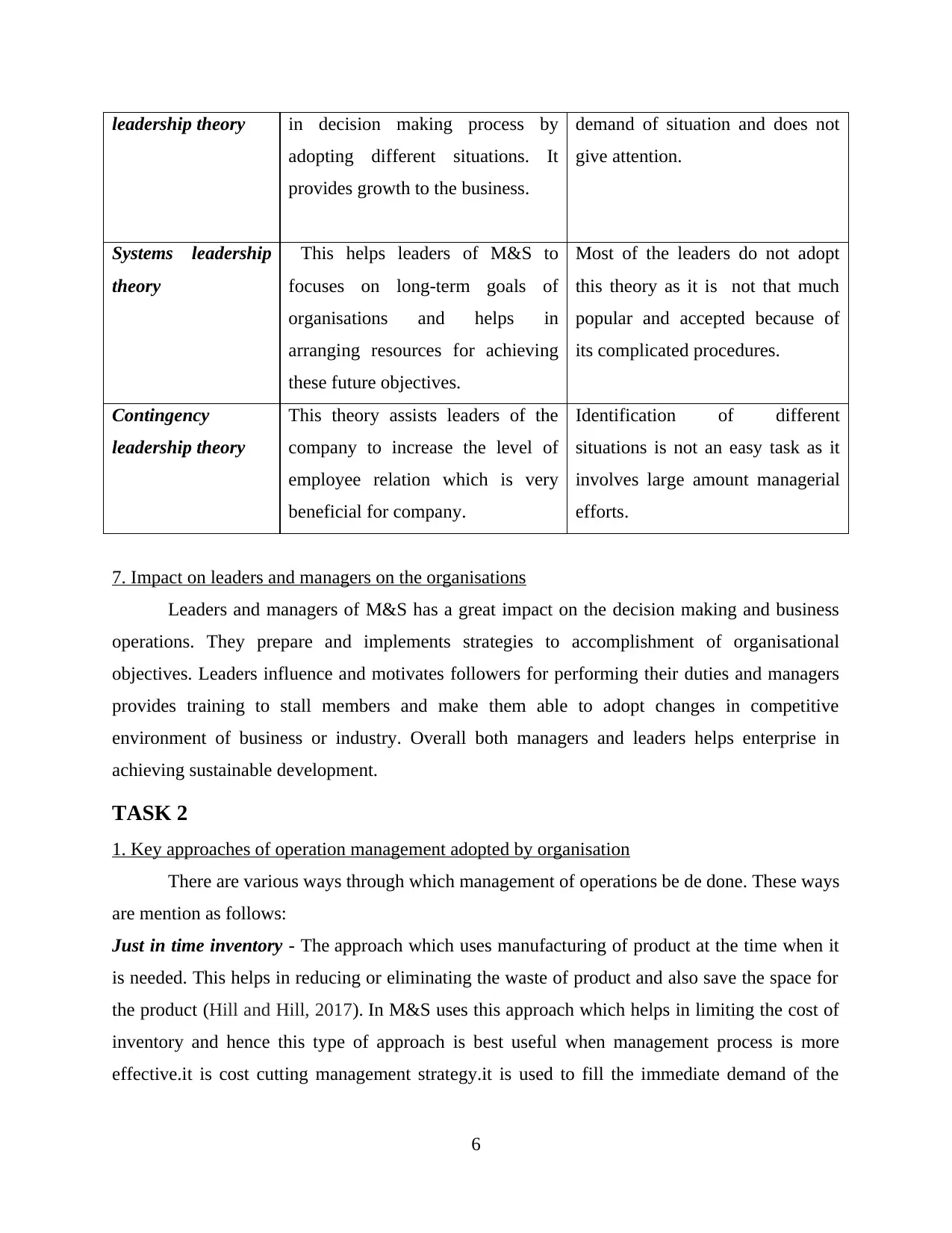
leadership theory in decision making process by
adopting different situations. It
provides growth to the business.
demand of situation and does not
give attention.
Systems leadership
theory
This helps leaders of M&S to
focuses on long-term goals of
organisations and helps in
arranging resources for achieving
these future objectives.
Most of the leaders do not adopt
this theory as it is not that much
popular and accepted because of
its complicated procedures.
Contingency
leadership theory
This theory assists leaders of the
company to increase the level of
employee relation which is very
beneficial for company.
Identification of different
situations is not an easy task as it
involves large amount managerial
efforts.
7. Impact on leaders and managers on the organisations
Leaders and managers of M&S has a great impact on the decision making and business
operations. They prepare and implements strategies to accomplishment of organisational
objectives. Leaders influence and motivates followers for performing their duties and managers
provides training to stall members and make them able to adopt changes in competitive
environment of business or industry. Overall both managers and leaders helps enterprise in
achieving sustainable development.
TASK 2
1. Key approaches of operation management adopted by organisation
There are various ways through which management of operations be de done. These ways
are mention as follows:
Just in time inventory - The approach which uses manufacturing of product at the time when it
is needed. This helps in reducing or eliminating the waste of product and also save the space for
the product (Hill and Hill, 2017). In M&S uses this approach which helps in limiting the cost of
inventory and hence this type of approach is best useful when management process is more
effective.it is cost cutting management strategy.it is used to fill the immediate demand of the
6
adopting different situations. It
provides growth to the business.
demand of situation and does not
give attention.
Systems leadership
theory
This helps leaders of M&S to
focuses on long-term goals of
organisations and helps in
arranging resources for achieving
these future objectives.
Most of the leaders do not adopt
this theory as it is not that much
popular and accepted because of
its complicated procedures.
Contingency
leadership theory
This theory assists leaders of the
company to increase the level of
employee relation which is very
beneficial for company.
Identification of different
situations is not an easy task as it
involves large amount managerial
efforts.
7. Impact on leaders and managers on the organisations
Leaders and managers of M&S has a great impact on the decision making and business
operations. They prepare and implements strategies to accomplishment of organisational
objectives. Leaders influence and motivates followers for performing their duties and managers
provides training to stall members and make them able to adopt changes in competitive
environment of business or industry. Overall both managers and leaders helps enterprise in
achieving sustainable development.
TASK 2
1. Key approaches of operation management adopted by organisation
There are various ways through which management of operations be de done. These ways
are mention as follows:
Just in time inventory - The approach which uses manufacturing of product at the time when it
is needed. This helps in reducing or eliminating the waste of product and also save the space for
the product (Hill and Hill, 2017). In M&S uses this approach which helps in limiting the cost of
inventory and hence this type of approach is best useful when management process is more
effective.it is cost cutting management strategy.it is used to fill the immediate demand of the
6
⊘ This is a preview!⊘
Do you want full access?
Subscribe today to unlock all pages.

Trusted by 1+ million students worldwide
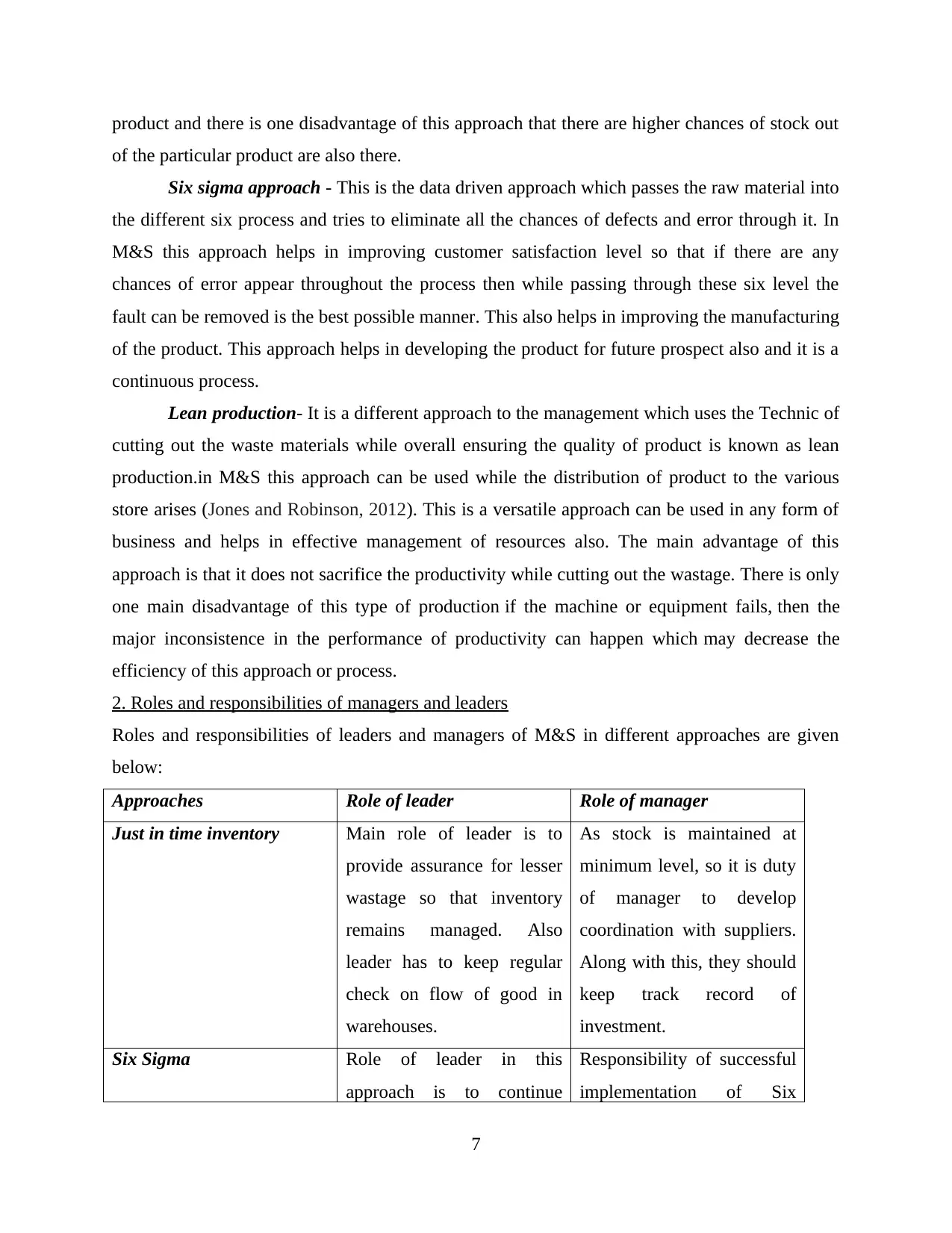
product and there is one disadvantage of this approach that there are higher chances of stock out
of the particular product are also there.
Six sigma approach - This is the data driven approach which passes the raw material into
the different six process and tries to eliminate all the chances of defects and error through it. In
M&S this approach helps in improving customer satisfaction level so that if there are any
chances of error appear throughout the process then while passing through these six level the
fault can be removed is the best possible manner. This also helps in improving the manufacturing
of the product. This approach helps in developing the product for future prospect also and it is a
continuous process.
Lean production- It is a different approach to the management which uses the Technic of
cutting out the waste materials while overall ensuring the quality of product is known as lean
production.in M&S this approach can be used while the distribution of product to the various
store arises (Jones and Robinson, 2012). This is a versatile approach can be used in any form of
business and helps in effective management of resources also. The main advantage of this
approach is that it does not sacrifice the productivity while cutting out the wastage. There is only
one main disadvantage of this type of production if the machine or equipment fails, then the
major inconsistence in the performance of productivity can happen which may decrease the
efficiency of this approach or process.
2. Roles and responsibilities of managers and leaders
Roles and responsibilities of leaders and managers of M&S in different approaches are given
below:
Approaches Role of leader Role of manager
Just in time inventory Main role of leader is to
provide assurance for lesser
wastage so that inventory
remains managed. Also
leader has to keep regular
check on flow of good in
warehouses.
As stock is maintained at
minimum level, so it is duty
of manager to develop
coordination with suppliers.
Along with this, they should
keep track record of
investment.
Six Sigma Role of leader in this
approach is to continue
Responsibility of successful
implementation of Six
7
of the particular product are also there.
Six sigma approach - This is the data driven approach which passes the raw material into
the different six process and tries to eliminate all the chances of defects and error through it. In
M&S this approach helps in improving customer satisfaction level so that if there are any
chances of error appear throughout the process then while passing through these six level the
fault can be removed is the best possible manner. This also helps in improving the manufacturing
of the product. This approach helps in developing the product for future prospect also and it is a
continuous process.
Lean production- It is a different approach to the management which uses the Technic of
cutting out the waste materials while overall ensuring the quality of product is known as lean
production.in M&S this approach can be used while the distribution of product to the various
store arises (Jones and Robinson, 2012). This is a versatile approach can be used in any form of
business and helps in effective management of resources also. The main advantage of this
approach is that it does not sacrifice the productivity while cutting out the wastage. There is only
one main disadvantage of this type of production if the machine or equipment fails, then the
major inconsistence in the performance of productivity can happen which may decrease the
efficiency of this approach or process.
2. Roles and responsibilities of managers and leaders
Roles and responsibilities of leaders and managers of M&S in different approaches are given
below:
Approaches Role of leader Role of manager
Just in time inventory Main role of leader is to
provide assurance for lesser
wastage so that inventory
remains managed. Also
leader has to keep regular
check on flow of good in
warehouses.
As stock is maintained at
minimum level, so it is duty
of manager to develop
coordination with suppliers.
Along with this, they should
keep track record of
investment.
Six Sigma Role of leader in this
approach is to continue
Responsibility of successful
implementation of Six
7
Paraphrase This Document
Need a fresh take? Get an instant paraphrase of this document with our AI Paraphraser
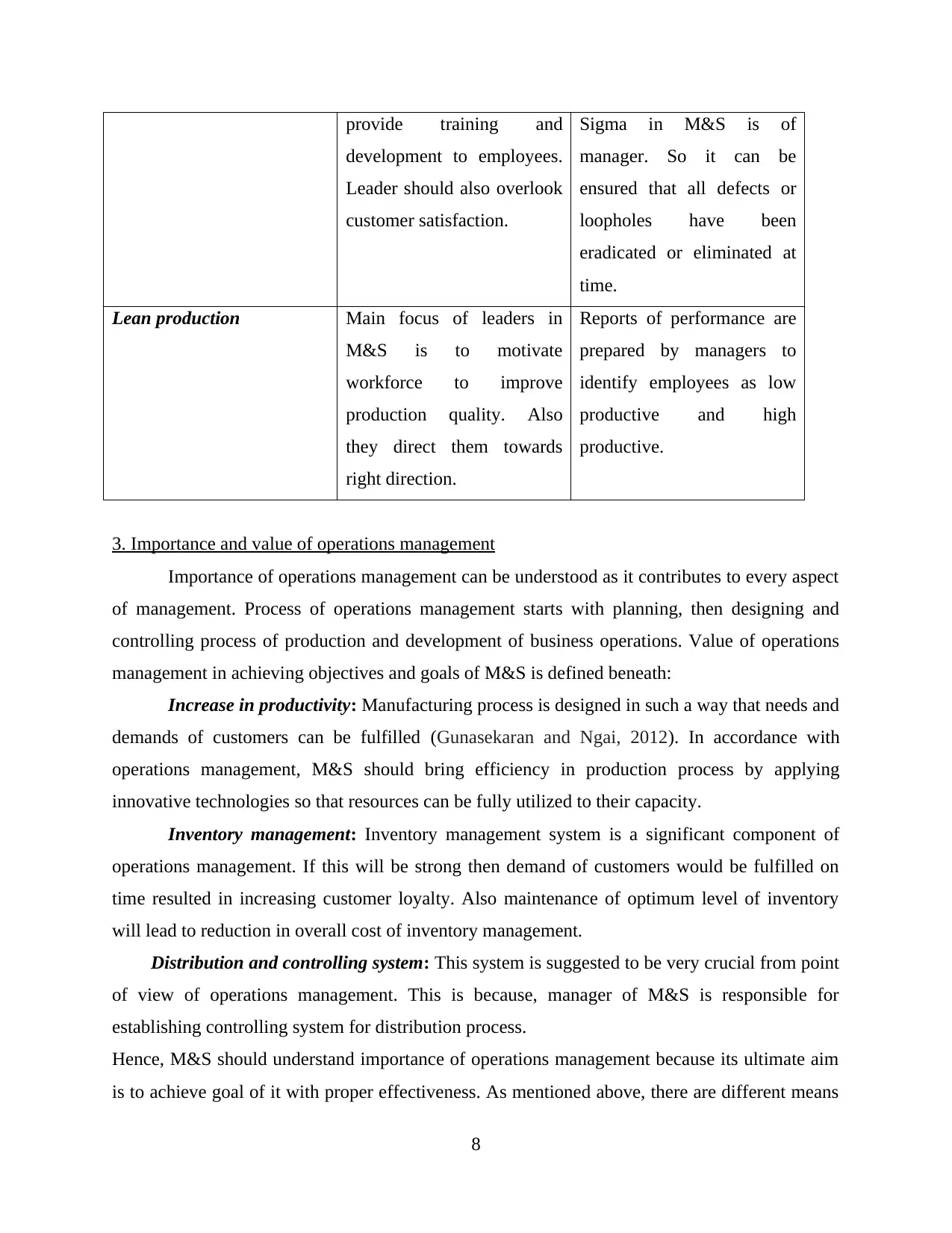
provide training and
development to employees.
Leader should also overlook
customer satisfaction.
Sigma in M&S is of
manager. So it can be
ensured that all defects or
loopholes have been
eradicated or eliminated at
time.
Lean production Main focus of leaders in
M&S is to motivate
workforce to improve
production quality. Also
they direct them towards
right direction.
Reports of performance are
prepared by managers to
identify employees as low
productive and high
productive.
3. Importance and value of operations management
Importance of operations management can be understood as it contributes to every aspect
of management. Process of operations management starts with planning, then designing and
controlling process of production and development of business operations. Value of operations
management in achieving objectives and goals of M&S is defined beneath:
Increase in productivity: Manufacturing process is designed in such a way that needs and
demands of customers can be fulfilled (Gunasekaran and Ngai, 2012). In accordance with
operations management, M&S should bring efficiency in production process by applying
innovative technologies so that resources can be fully utilized to their capacity.
Inventory management: Inventory management system is a significant component of
operations management. If this will be strong then demand of customers would be fulfilled on
time resulted in increasing customer loyalty. Also maintenance of optimum level of inventory
will lead to reduction in overall cost of inventory management.
Distribution and controlling system: This system is suggested to be very crucial from point
of view of operations management. This is because, manager of M&S is responsible for
establishing controlling system for distribution process.
Hence, M&S should understand importance of operations management because its ultimate aim
is to achieve goal of it with proper effectiveness. As mentioned above, there are different means
8
development to employees.
Leader should also overlook
customer satisfaction.
Sigma in M&S is of
manager. So it can be
ensured that all defects or
loopholes have been
eradicated or eliminated at
time.
Lean production Main focus of leaders in
M&S is to motivate
workforce to improve
production quality. Also
they direct them towards
right direction.
Reports of performance are
prepared by managers to
identify employees as low
productive and high
productive.
3. Importance and value of operations management
Importance of operations management can be understood as it contributes to every aspect
of management. Process of operations management starts with planning, then designing and
controlling process of production and development of business operations. Value of operations
management in achieving objectives and goals of M&S is defined beneath:
Increase in productivity: Manufacturing process is designed in such a way that needs and
demands of customers can be fulfilled (Gunasekaran and Ngai, 2012). In accordance with
operations management, M&S should bring efficiency in production process by applying
innovative technologies so that resources can be fully utilized to their capacity.
Inventory management: Inventory management system is a significant component of
operations management. If this will be strong then demand of customers would be fulfilled on
time resulted in increasing customer loyalty. Also maintenance of optimum level of inventory
will lead to reduction in overall cost of inventory management.
Distribution and controlling system: This system is suggested to be very crucial from point
of view of operations management. This is because, manager of M&S is responsible for
establishing controlling system for distribution process.
Hence, M&S should understand importance of operations management because its ultimate aim
is to achieve goal of it with proper effectiveness. As mentioned above, there are different means
8
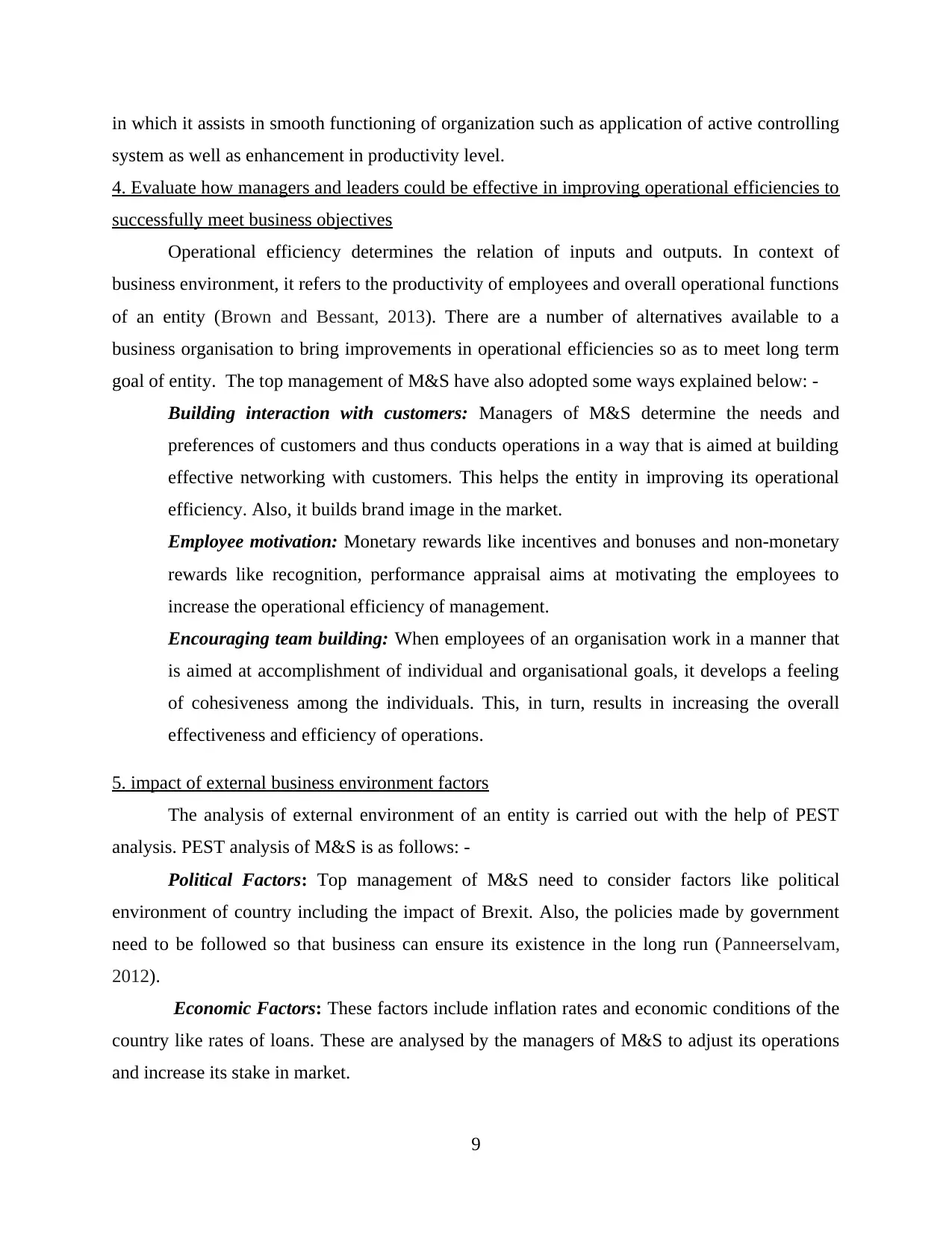
in which it assists in smooth functioning of organization such as application of active controlling
system as well as enhancement in productivity level.
4. Evaluate how managers and leaders could be effective in improving operational efficiencies to
successfully meet business objectives
Operational efficiency determines the relation of inputs and outputs. In context of
business environment, it refers to the productivity of employees and overall operational functions
of an entity (Brown and Bessant, 2013). There are a number of alternatives available to a
business organisation to bring improvements in operational efficiencies so as to meet long term
goal of entity. The top management of M&S have also adopted some ways explained below: -
Building interaction with customers: Managers of M&S determine the needs and
preferences of customers and thus conducts operations in a way that is aimed at building
effective networking with customers. This helps the entity in improving its operational
efficiency. Also, it builds brand image in the market.
Employee motivation: Monetary rewards like incentives and bonuses and non-monetary
rewards like recognition, performance appraisal aims at motivating the employees to
increase the operational efficiency of management.
Encouraging team building: When employees of an organisation work in a manner that
is aimed at accomplishment of individual and organisational goals, it develops a feeling
of cohesiveness among the individuals. This, in turn, results in increasing the overall
effectiveness and efficiency of operations.
5. impact of external business environment factors
The analysis of external environment of an entity is carried out with the help of PEST
analysis. PEST analysis of M&S is as follows: -
Political Factors: Top management of M&S need to consider factors like political
environment of country including the impact of Brexit. Also, the policies made by government
need to be followed so that business can ensure its existence in the long run (Panneerselvam,
2012).
Economic Factors: These factors include inflation rates and economic conditions of the
country like rates of loans. These are analysed by the managers of M&S to adjust its operations
and increase its stake in market.
9
system as well as enhancement in productivity level.
4. Evaluate how managers and leaders could be effective in improving operational efficiencies to
successfully meet business objectives
Operational efficiency determines the relation of inputs and outputs. In context of
business environment, it refers to the productivity of employees and overall operational functions
of an entity (Brown and Bessant, 2013). There are a number of alternatives available to a
business organisation to bring improvements in operational efficiencies so as to meet long term
goal of entity. The top management of M&S have also adopted some ways explained below: -
Building interaction with customers: Managers of M&S determine the needs and
preferences of customers and thus conducts operations in a way that is aimed at building
effective networking with customers. This helps the entity in improving its operational
efficiency. Also, it builds brand image in the market.
Employee motivation: Monetary rewards like incentives and bonuses and non-monetary
rewards like recognition, performance appraisal aims at motivating the employees to
increase the operational efficiency of management.
Encouraging team building: When employees of an organisation work in a manner that
is aimed at accomplishment of individual and organisational goals, it develops a feeling
of cohesiveness among the individuals. This, in turn, results in increasing the overall
effectiveness and efficiency of operations.
5. impact of external business environment factors
The analysis of external environment of an entity is carried out with the help of PEST
analysis. PEST analysis of M&S is as follows: -
Political Factors: Top management of M&S need to consider factors like political
environment of country including the impact of Brexit. Also, the policies made by government
need to be followed so that business can ensure its existence in the long run (Panneerselvam,
2012).
Economic Factors: These factors include inflation rates and economic conditions of the
country like rates of loans. These are analysed by the managers of M&S to adjust its operations
and increase its stake in market.
9
⊘ This is a preview!⊘
Do you want full access?
Subscribe today to unlock all pages.

Trusted by 1+ million students worldwide
1 out of 15
Related Documents
Your All-in-One AI-Powered Toolkit for Academic Success.
+13062052269
info@desklib.com
Available 24*7 on WhatsApp / Email
![[object Object]](/_next/static/media/star-bottom.7253800d.svg)
Unlock your academic potential
Copyright © 2020–2025 A2Z Services. All Rights Reserved. Developed and managed by ZUCOL.





